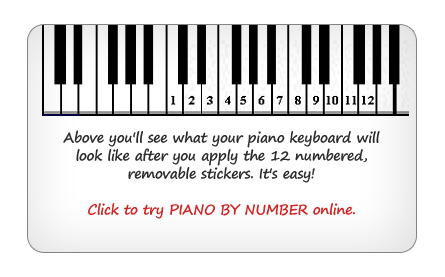There Are Many Ways To Start Piano

There are many ways to start piano. By number, by tab, by color, by animal, by note, by ear, by eye.
Choose your poison.
These alternative methods exist because musical notation is a difficult but perfect system. Musical notation is so perfect, in fact, that it is almost impossibly complex.
Even in the easiest forms, it is very hard to learn.
It is like chess. Yes, chess is similar to checkers, but chess is infinitely more complex.
Thus musical notation is a poor starting platform for kids.
Piano Is Easy
The Child Is More Important Than The Curriculum
The pedant's solution to this problem is to only allow beginners to play the most boring of "exercise" pieces. These teachers go from page to page without regard for the child's reaction. If the child is bored, they are deemed "lazy," or "untalented."
The question of whether this curriculum is interesting to children has been answered: they hate it. But kids also hate the other "starting methods," mostly because they can not take the child far enough.
Try Piano By Animal and you'll get sick of the lion sticker very soon. Colors and animals are for babies, and the list of objections to such methods are endless. Start with the fact that animals and colors are completely irrelevant to the piano.
So these alternative methods either make it too hard (notes) or too easy (animals.) Either way kids get bored and quit.
Numbers Fit Kids Perfectly
What we need is a Goldilocks system, one is that is "just right." Piano By Number is easy because it is one-dimensional. Piano By Number is "just right" for most kids because numbers are second nature to them.
Animals, colors, all these become irrelevant once real musical study begins. In contrast, numbers remain relevant, even in the realm of musical notation.
Numbers Are The Gateway To Notes
So numbers provide an easy entry way into notes. Complex enough to be interesting, but not so foreign (notes) as to inspire fear. Almost any piece can be rendered into numbers, and this is not true of any other "starting method." Thus Piano By Number can take you further into complexity before you have to resort to reading music.
Difference Between Numbers And Notes
Instead of circular notes and horizontal lines, Piano By Number uses numbers in a single row. The piano is prepared by putting numbered stickers on the keys. It is then easy for the child to find the key on the piano that corresponds to the number in the book. See below.

Kids Must Make Music Immediately
Above is a sample page from a Piano by Number book, showing the song Jingle Bells expressed in numbers, and above that a numbered keyboard. The objective is to get the child to make recognizable music right away. There will be time enough for reading music.
Thus equipped with Piano By Number, the child should embark on an exploration of every song they have ever heard.
Learn The Physical Skills Before You Read
Many of the key elements of piano curriculum can be taught without reference to notes on a page: fingering, hand position, rhythm, chords, playing with both hands. All of these skills can be mastered at the child's pace, and, when they are ready, they can read music and start piano lessons.
In fact, it is easier for kids to get the idea of fingering if they are not simultaneously beset with reading notes. One thing at a time.
REFERENCES
Introductory
Eight Best Ways To Learn Piano For Beginners
Playing Piano By Number
Playing Piano By Number – Complete
Starting To Play Piano By Number
Beginning Piano Music With Numbers
Beginner Piano Tutorial
Beginner Piano Books for Kids
Introduction To Piano By Number
Music On The Mind: Newsweek Articles
Piano By Number Basics
Piano By Number Is The Missing Step
A History of Piano and Numbers
Basic Piano Skills for Kids
Easy Piano Songs for Beginners with Letters
Easy Piano Notes for Popular Songs





